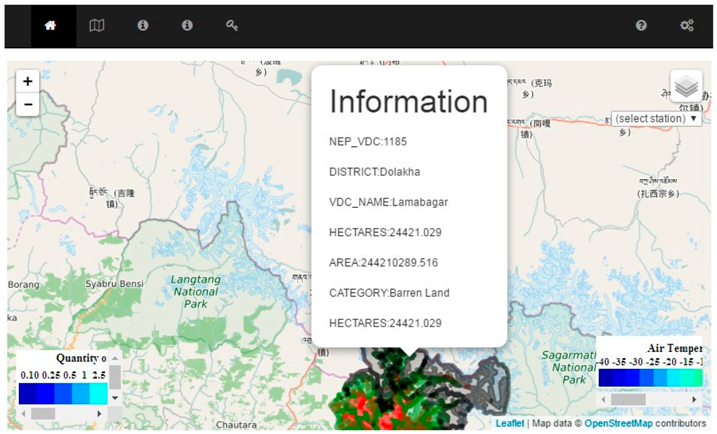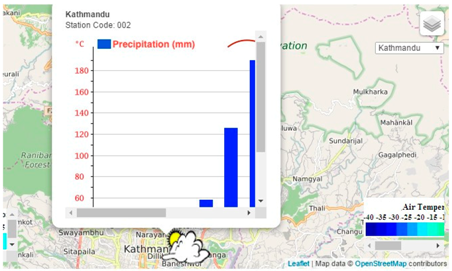Evaluating a Fit-For-Purpose Integrated Service-Oriented Land and Climate Change Information System for Mountain Community Adaptation
Abstract
1. Introduction
2. Background
3. Materials and Methods
3.1. Study Area and Its Context
3.2. Agile-Inspired Development Process
3.3. Information System Architecture
3.4. Information System Evaluation Criteria
3.5. Test Plan
4. User Evaluation Results
4.1. Flexible
4.2. Inclusive
4.3. Participatory
4.4. Affordable
4.5. Reliable
4.6. Attainable
4.7. Upgradeable
5. Discussion
5.1. Lessons from the Design Process
5.2. Remaining Challenges for the Tool
5.3. Institutional Opportunities and Challenges
6. Conclusions
Author Contributions
Funding
Acknowledgments
Conflicts of Interest
Appendix A. MCAS User Guide
- Double-click on the index web page for opening the home page on the browser.
- There is title bar on the top with the symbol, and name you can select map, license, home, help, and about us.
- Click on the top left button
zoom in/out, even you can scroll mouse for zooming in and out.
- Click on the top right button
for selecting layers such as land use categories, village, contour, Cadastre, administrative boundaries, temperature, and precipitation.
- You can switch layers, overlay layers, and click for the popup that contains attribute.
- Click on the button name, select, station for selecting three meteorological stations.
- Click on the layer name, select, temperature and precipitation for knowing up-to-date temperature and precipitation.
- Double-click on the index web page to open the home page on the browser.
- There is a title bar on the top with the symbols. You can select map, license, home, help, and about us.
- You can switch layers, overlay layers, and click for the popup that contains attribute.
- Click on the button name, select, station to select each of the three meteorological stations.
- When you click on the meteorological station such as Kathmandu, you can see monthly precipitation and temperature in a graph format.
- Click on the top right button for selecting layers such as land use categories, village, contour, cadastre, administrative boundaries, temperature, and precipitation.
References
- Zheng, Y.; Dallimer, M. What motivates rural households to adapt to climate change? Clim. Dev. 2015, 1–12. [Google Scholar] [CrossRef]
- Ayers, J.; Forsyth, T. Community-Based Adaptation to Climate Change. Environ. Sci. Policy Sustain. Dev. 2009, 51, 22–31. [Google Scholar] [CrossRef]
- Sarzynski, A. Public participation, civic capacity, and climate change adaptation in cities. Urban Clim. 2015, 14, 52–67. [Google Scholar] [CrossRef]
- Pörtner, H.-O.; Karl, D.; Boyd, P.W.; Cheung, W.; Lluch-Cota, S.E.; Nojiri, Y.; Schmidt, D.N.; Zavialov, P.O.; Alheit, J.; Aristegui, J.; et al. Ocean systems. In Clim Chang 2014 Impacts, Adapt Vulnerability Part A Glob Sect Asp WGII Fifth Assess Rep IPCC; Drinkwater, K., Polonsky, A., Eds.; Cambridge University Press: Cambridge, UK, 2014. [Google Scholar]
- Syomiti, M.; Shelat, K.N.; Adaptation, T.S. Vulnerability of Agriculture, Water and Fisheries to Climate Change; Behnassi, M., Syomiti Muteng’e, M., Ramachandran, G., Shelat, K.N., Eds.; Springer: Dordrecht, The Netherlands, 2014. [Google Scholar]
- Regmi, B.R. Revisiting Community-Based Adaptation. Available online: wwwForestrynepalOrg (accessed on 5 January 2017).
- Heltberg, R.; Gitay, H.; Prabhu, R.G. Community-based adaptation: Lessons from a grant competition. Clim. Policy 2012, 12, 143–163. [Google Scholar] [CrossRef]
- King, S. Community-Based Adaptation: A Global Overview of CARE International’s Practice of Community-Based Adaptation (CBA) to Climate Change; CARE International: London, UK, 2014. [Google Scholar]
- Berrang-Ford, L.; Ford, J.D.; Paterson, J. Are we adapting to climate change? Glob. Environ. Chang. 2011, 21, 25–33. [Google Scholar] [CrossRef]
- Lieske, D.J. Coping with climate change: The role of spatial decision support tools in facilitating community adaptation. Environ. Model. Softw. 2015, 68, 98–109. [Google Scholar] [CrossRef]
- Gruen, A.; Murai, S. Special issue: Geomatics in mountainous areas—The International Year of the Mountains 2002. ISPRS J. Photogramm. Remote Sens. 2002, 57, 1–4. [Google Scholar] [CrossRef]
- Veregin, H.; Longley, P.A.; Goodchild, M.F.; Maguire, D.J.; Rhind, D.W. (Eds.) Data quality parameters. Geogr. Inf. Syst. 2005, 1, 177–190. Available online: http://www.geos.ed.ac.uk/~gisteac/gis_book_abridged/files/ch12.pdf (accessed on 5 July 2017).
- Sjoberg, R.W.; Horn, B.K. Atmospheric effects in satellite imaging of mountainous terrain. Appl. Opt. 1983, 22, 1702. [Google Scholar] [CrossRef] [PubMed]
- Fassnacht, K.S.; Cohen, W.B.; Spies, T.A. Key issues in making and using satellite-based maps in ecology: A primer. For. Ecol. Manag. 2006, 222, 167–181. [Google Scholar] [CrossRef]
- Ospina, A.V.; Heeks, R. ICTs and Climate Change Adaptation: Enabling Innovative Strategies. Strateg. Brief-1 Clim. Chang. Innov. ICTs Proj. 2011, 17, 1–9. [Google Scholar]
- Wamsler, C.; Brink, E. Moving beyond short-term coping and adaptation. Environ. Urban. 2014, 26, 86–111. [Google Scholar] [CrossRef]
- Bartoli, F.; Medaglia, C.M. GeoAvalanche—Spatial Data Infrastructure for avalanche awareness warning. In Proceedings of the 2012 FIG Working Week, Knowing to Manage the Territory, Protect the Environment, Evaluate the Cultural Heritage, Rome, Italy, 6–10 May 2012. [Google Scholar]
- Geopraevent, A.G. Geopraevent. 2017. Available online: http://www.geopraevent.ch/?lang=en (accessed on 2 August 2017).
- International Centre for Integrated Mountain Development (ICIMOD). Citizen Scientists Aid Winter Fog Study with Mobile App. 2016. Available online: http://www.icimod.org/?q=22713 (accessed on 1 January 2017).
- Food and Agriculture Organization (FAO). The Voluntary Guidelines on the Responsible Governance of Tenure of Land, Fisheries and Forests in the Context of National Food Security; Food and Agriculture Organization: Roma, Italy, 2012; Available online: http://www.fao.org/docrep/016/i2801e/i2801e.pdf (accessed on 5 January 2017).
- Mitchell, D.; Enemark, S.; van der Molen, P. Climate resilient urban development: Why responsible land governance is important. Land Use Policy 2015, 48, 190–198. [Google Scholar] [CrossRef]
- Enemark, S.; Bell, K.C.; Lemmen, C.H.J.; McLaren, R. Fit-For-Purpose Land Administration; Enemark, S., Ed.; World Bank and International Federation of Surveyors: Copenhagen, Denmark, 2015. [Google Scholar]
- International Federation of Surveyors (FIG). The Surveyor’s Role in Monitoring, Mitigating, and Adapting to Climate Change; International Federation of Surveyors: Copenhagen, Denmark, 2014. [Google Scholar]
- Enemark, S.; McLaren, R.; Lemmen, C. Fit-For-Purpose Land Administration Guiding Principles; Global Land Tool Network (GLTN): Copenhagen, Denmark, 2015. [Google Scholar]
- Eckstein, D.; Künzel, V.; Schäfer, L. Global Climate Risk Index 2018: Who Suffers Most from Extreme Weather Events? Weather-Related Loss Events in 2016 and 1997 to 2016. 2017. Available online: https://germanwatch.org/en/download/7170.pdf (accessed on 21 March 2018).
- Ministry of Environment. Climate Change Vulnerability Mapping for Nepal; Ministry of Environment: Kathmandu, Nepal, 2010.
- Khezri, A.; Bennett, R.; Zevenbergen, J. Defining the Requirements of an Information System for Climate Change Adaptation in the Mountain. MDPI-Clim. 2018, 6, 47. [Google Scholar]
- Dennis, A.; Haley Wixom, B.; Roth, M.R. System Analysis and Design, 5th ed.; Wiley: Hoboken, NJ, USA, 2012. [Google Scholar]
- Johannessen, L.K.; Ellingsen, G. Integration and generification-agile software development in the healthcare market. Comput. Support. Coop. Work 2009, 18, 607–634. [Google Scholar] [CrossRef]
- Moe, N.B.; Dingsøyr, T.; Dybå, T. A teamwork model for understanding an agile team: A case study of a Scrum project. Inf. Softw. Technol. 2010, 52, 480–491. [Google Scholar] [CrossRef]
- Meso, P.; Jain, R. Agile Software Development: Adaptive Systems Principles and Best Practices. Inf. Syst. Manag. 2006, 23, 19–30. [Google Scholar] [CrossRef]
- Dingsøyr, T.; Nerur, S.; Balijepally, V.; Moe, N.B. A decade of agile methodologies: Towards explaining agile software development. J. Syst. Softw. 2012, 85, 1213–1221. [Google Scholar] [CrossRef]
- Schwaber, K. Agile Project Management with Scrum; Microsoft Press: Redmond, WA, USA, 2004; Available online: http://www.amazon.com/dp/073561993X (accessed on 9 February 2017).
- Barton, J.E.; Goldie, X.H.; Pettit, C.J. Introducing a usability framework to support urban information discovery and analytics. J. Spat. Sci. 2015, 60, 311–327. [Google Scholar] [CrossRef]
- Beck, K. Extreme Programming Explained: Embrace Change; Addison-Wesley Longman: Boston, MA, USA, 2000. [Google Scholar]
- Misra, H. Users’ computer human interface capabilities in information system development life cycle: An organizational perspective. In Proceedings of the 2008 IEEE International Engineering Management Conference, Estoril, Portugal, 28–30 June 2008; pp. 1–5. [Google Scholar]
- DeLone, W.H.; Mclean, E.R. The DeLone and McLean Model of Information Systems Success: A Ten-Year Update. J. Manag. Inf. Syst. 2003, 19, 9–30. [Google Scholar]
- Bennett, R.; Alemie, B.K. Fit-for-purpose land administration: Lessons from urban and rural Ethiopia. Surv. Rev. 2016, 48, 11–20. [Google Scholar] [CrossRef]
- Bryman, A. Social Research Methods, 5th ed.; Oxford University Press: Oxford, UK, 2016. [Google Scholar]
- Guest, G.; Namey, E.E.; Mitchell, M.L. Participant Observation; Sage Publications: London, UK, 2013; pp. 75–112. [Google Scholar]
- Bugs, G.; Granell, C.; Fonts, O.; Huerta, J.; Painho, M. An assessment of Public Participation GIS and Web 2.0 technologies in urban planning practice in Canela, Brazil. Cities 2010, 27, 172–181. [Google Scholar] [CrossRef]
- Hammoudi, K.; Dornaika, F.; Soheilian, B.; Paparoditis, N. Extracting Wire-Frame Models of Street Facades From 3D Point Clouds and the Corresponding Cadastral Map. IAPRS 2010, 38, 91–96. [Google Scholar]
- Zevenbergen, J. A Systems Approach to Land Registration and Cadastre. Nord. J. Surv. Real Estate Res. 2004, 1, 11–24. [Google Scholar]
- Campelo, N.D.S.; Santoro Filho, M.J.G.; Valadares, O.C.D.P.; Paes, M.D.D.C.; Aragão, A.F. Georeferenced monitoring of displacements of gabion walls. Geotech. Eng. 2018, 171, 64–77. [Google Scholar] [CrossRef]
- OpenStreetMap. 2017. Available online: https://en.wikipedia.org/wiki/OpenStreetMap (accessed on 1 January 2017).
- Thapa, D.; Sæbø, Ø. Demystifying the possibilities of ICT4D in the mountain regions of Nepal. In Proceedings of the 2011 44th Hawaii International Conference on System Sciences, Kauai, HI, USA, 4–7 January 2011; pp. 1–10. [Google Scholar]
- OpenWeatherMap. Open Weather Map. 2017. Available online: https://openweathermap.org/technology (accessed on 12 November 2017).
- Li, B.; Griffith, D.A.; Becker, B. Spatially simplified scatterplots for large raster datasets. Geo-Spat. Inf. Sci. 2016, 19, 81–93. [Google Scholar] [CrossRef]
- Kumar, V.; Bansal, A.; Muttoo, S.K. Hiding Information in Vector Layer While Extracting Layers from Raster Data. Inf. Secur. J. 2012, 21, 317–327. [Google Scholar] [CrossRef]
- Cimato, F.; Mullan, M. Adapting to Climate Change: Analysing the Role of Government; Department for Environment Food & Rural Affairs: London, UK, 2010; p. 78. [Google Scholar]
- Simbizi, D.M.C. Measuring Land Tenure Security: A Pro-Poor Perspective; University of Twente Faculty of Geo-Information and Earth Observation (ITC): Enschede, The Netherlands, 2016. [Google Scholar]
- Furuholt, B.; Wahid, F.; Sæbø, Ø. Land information systems for development (LIS4D): A neglected area within ICT4D research? In Proceedings of the 2015 48th Hawaii International Conference on System Sciences, Kauai, HI, USA, 5–8 January 2015.
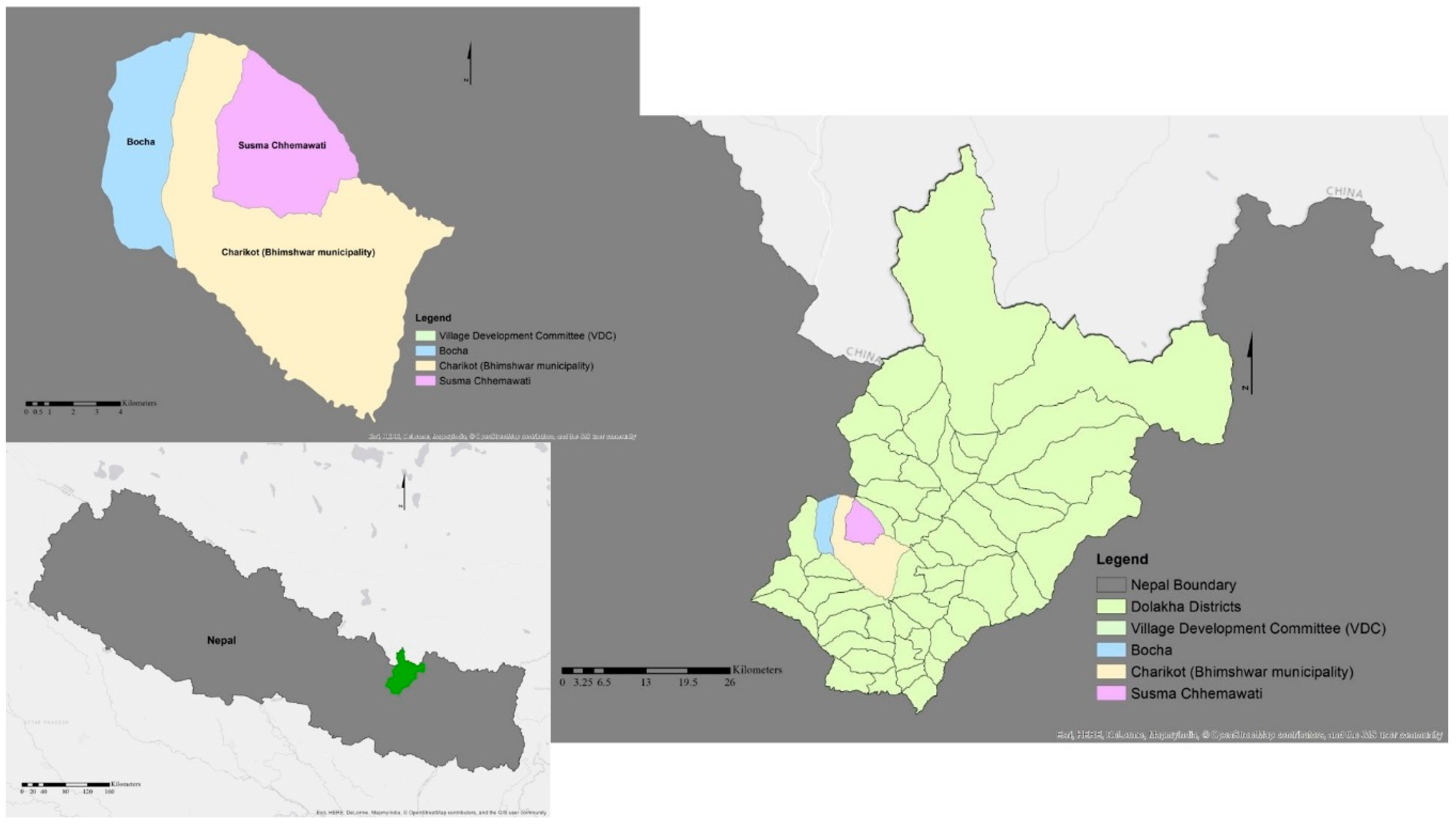
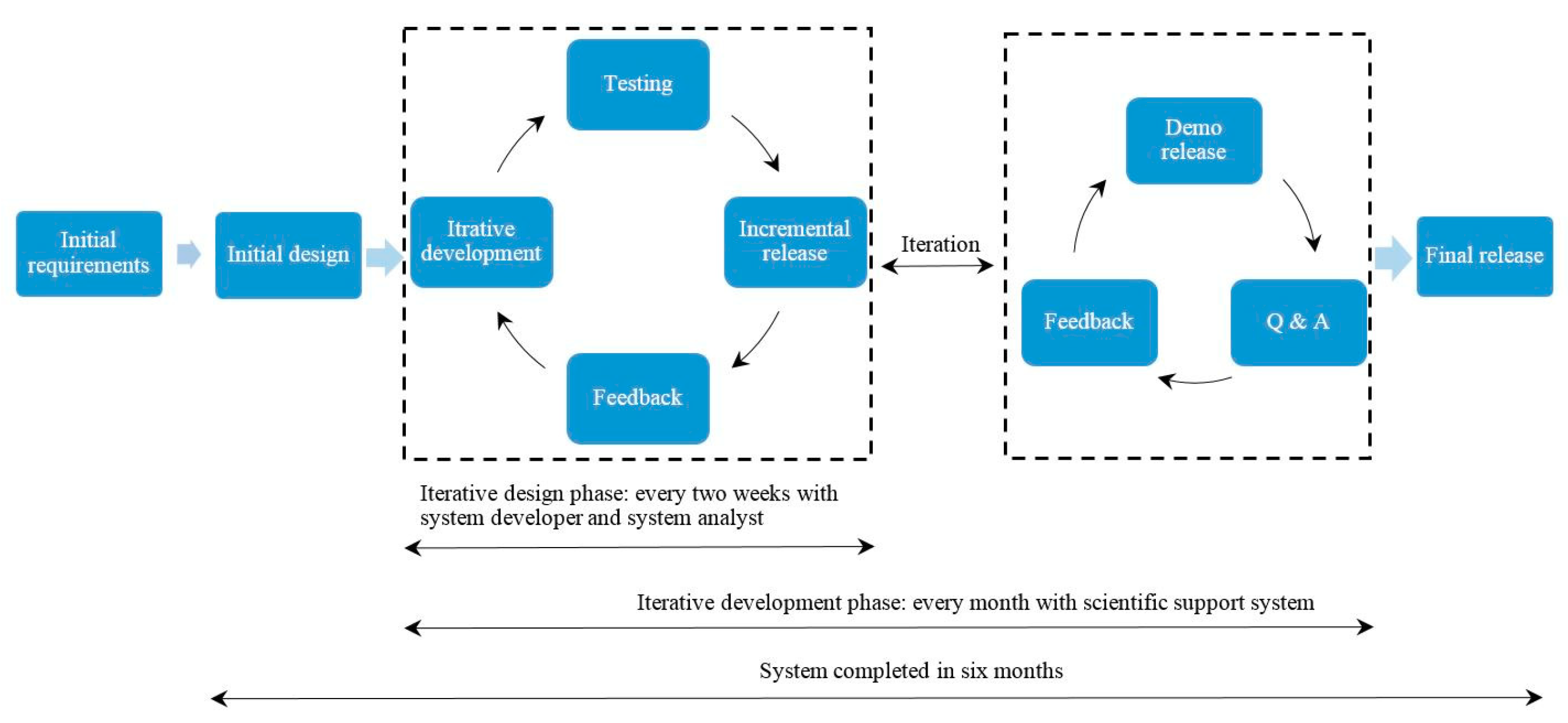

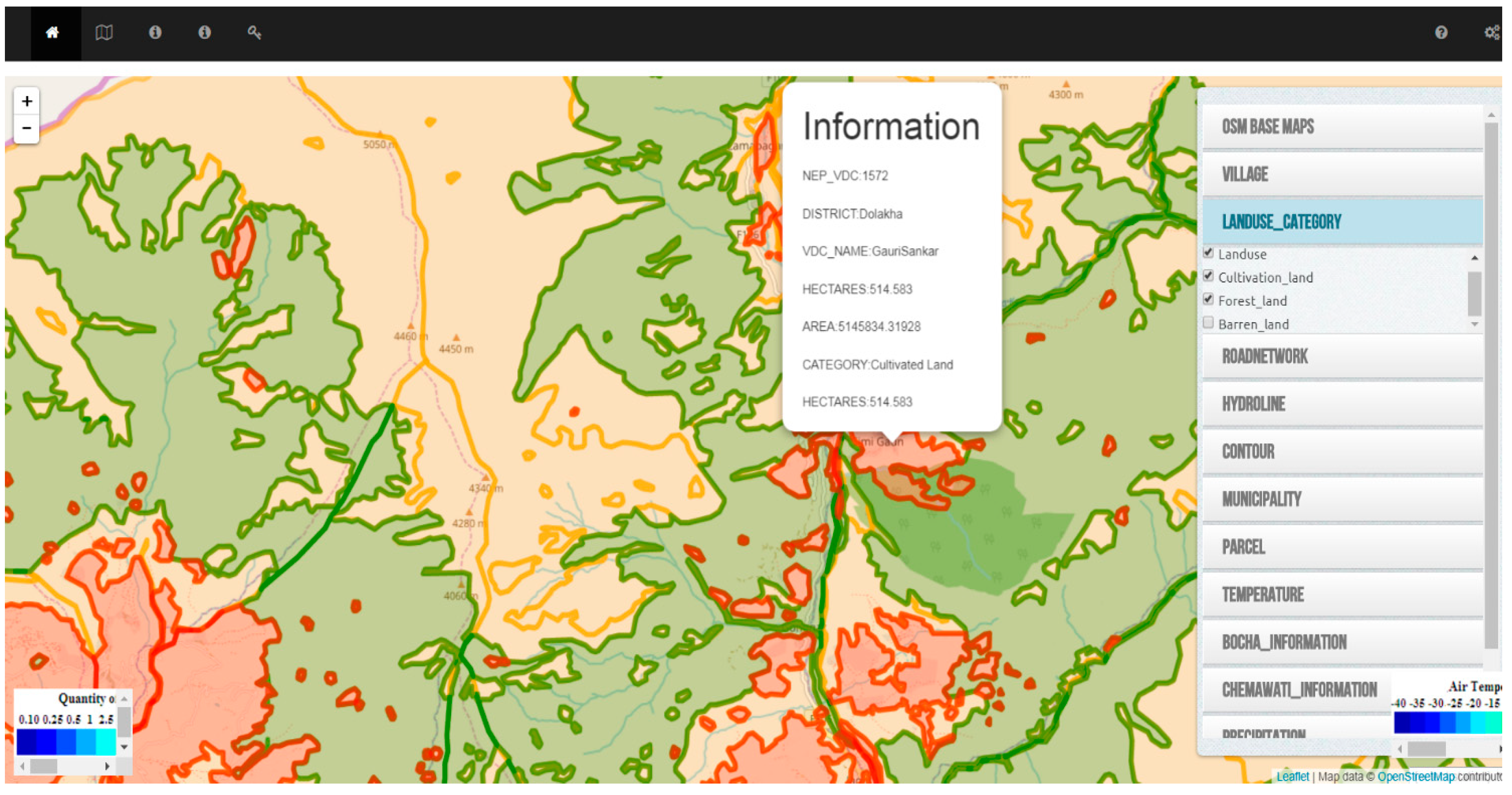
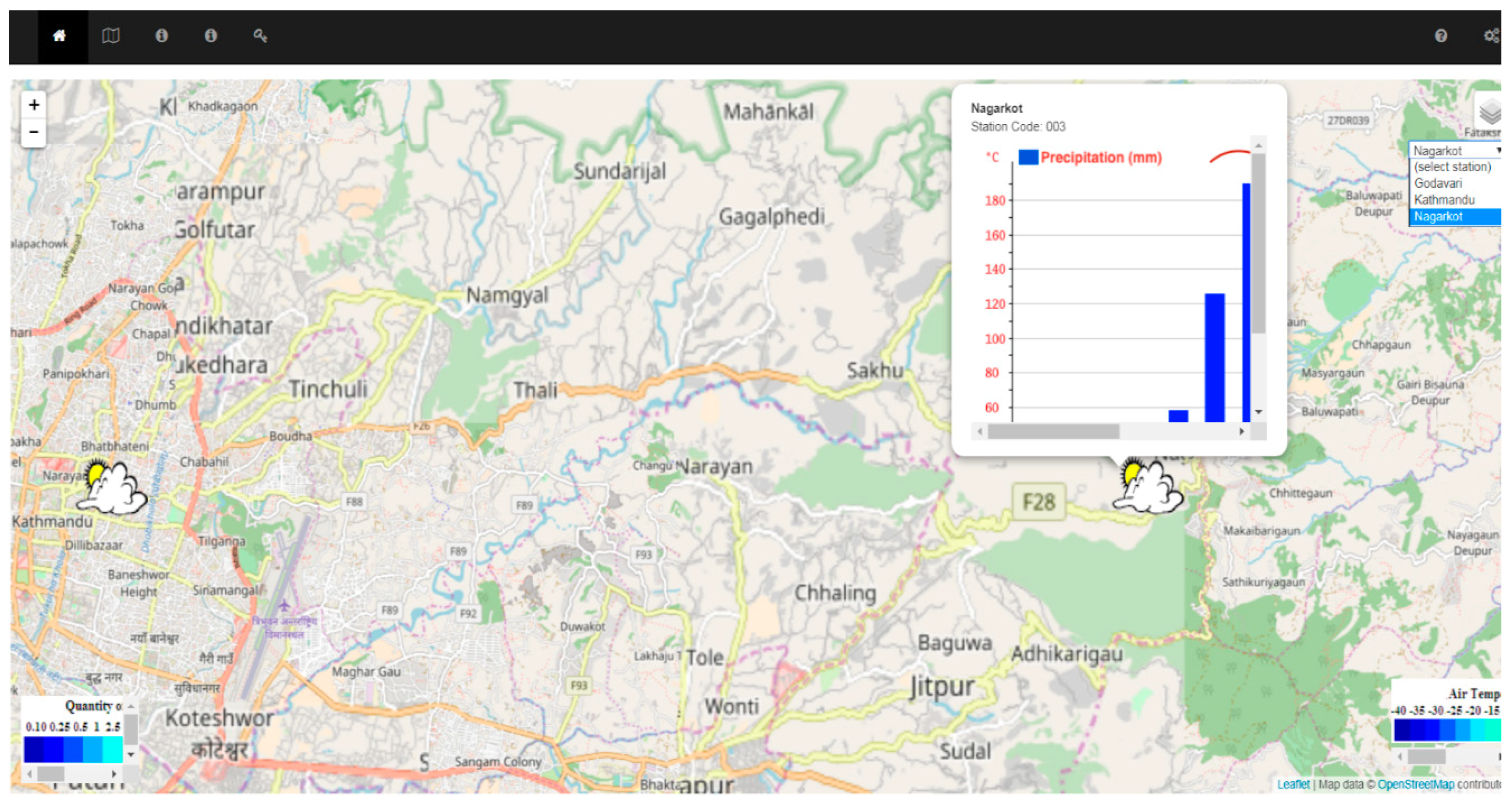
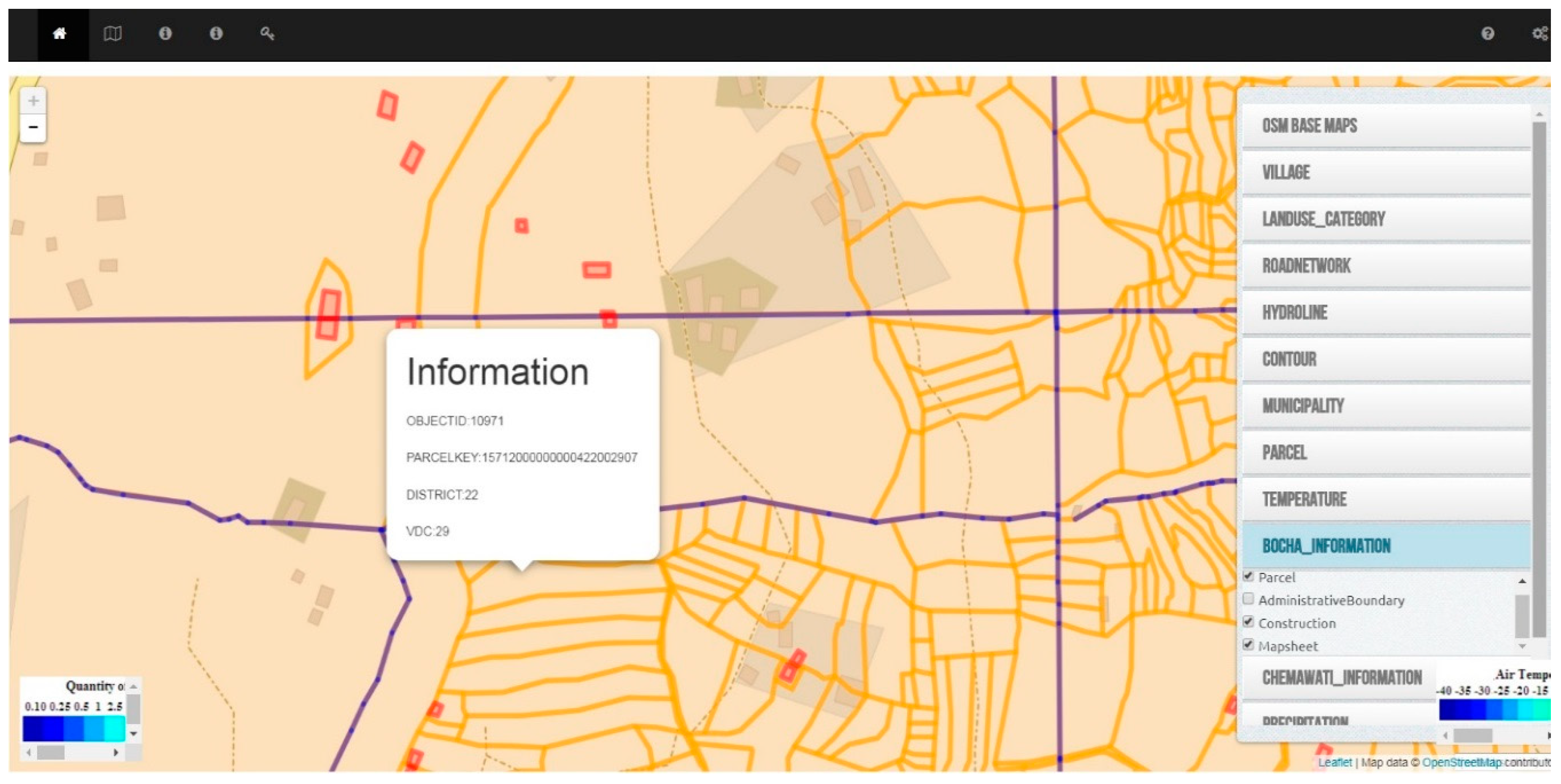
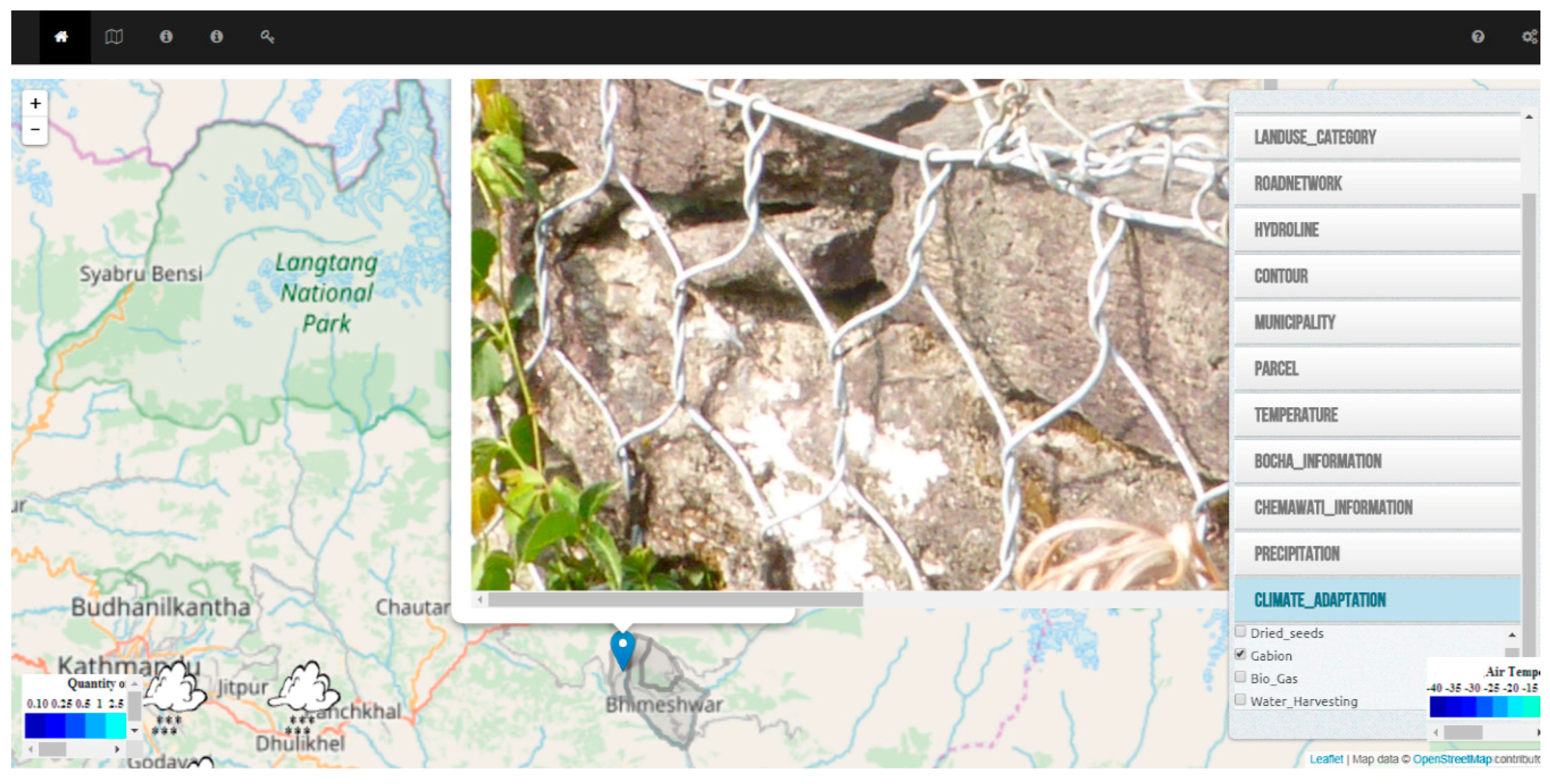
| App Name | App Domain | App Information | Webpage ** | Open Source Software |
|---|---|---|---|---|
| MySeasons * | Biodiversity | Monitoring vegetation phenology | http://myseasons.eu/ | CITnet |
| Atmos * | Weather | Providing short-term predictions on current meteorological conditions | http://beja.m-iti.org/web// | GitHUb CITnet |
| Protar.org * | Land cover | Providing land cover change in protected areas across Europe | http://www.protar.org/ | GitHUb CITnet |
| Geoss2go * | Mapping | Digital field mapping of tourism, agriculture and risk management | http://moovida.github.io/geoss2go/ | GitHUb CITnet |
| CALIOPE EU * | Air quality, air pollution | Forecasting 48-h air quality over Europe | http://www.bsc.es/caliope/en?language=en | CITnet |
| Fog Watch | Weather | Presenting the presence and intensity of fog | http://www.icimod.org/?q=22713 | NA |
| Open Source Tools | Version | Function | Source |
|---|---|---|---|
| Quantum GIS (QGIS) | 2.18.3 | Create, edit, visualize, analyze and publish spatial data | http://www.qgis.org/en/site/ |
| Geographic JavaScript Object Notation (GeoJSON) | RFC 7946 | Encoding geographic data feature | http://geojson.org/geojson-spec.html#introduction |
| Leaflet | 0.7.7 | JavaScript library | http://leafletjs.com/ |
| Bootstrap | 3.3.7 | HTML, CSS, and JS framework | http://getbootstrap.com/ |
| JavaScript | ECMAScript | Coding language | https://www.javascript.com/ |
| jQuery | Core 3.0 | Feature-rich JavaScript library | https://jquery.com/ |
| Elements of FFP LA | Adapted to MCAS |
|---|---|
| ‘Flexible in capturing the spatial data. | Flexible in capturing spatial and non-spatial land and climate change data. |
| Inclusive in scope to cover all tenure and all land. | Inclusive of all types of land tenure that are relevant to Community-Based Adaptations (CBAs). |
| Participatory in approach to data capture and use to ensure community support. | Participatory in sharing information about the effects of climate change on their land and livelihoods, and implementation of current CBA. |
| Affordable for the government to establish and operate, and for society to use. | Affordable for the community/individual to invest in relevant technology devices and supportive infrastructure to access the provided services. |
| Reliable in terms of information that is authoritative and up-to-date. | Reliable not only regarding cadastral data, but also for climate adaptation services. |
| Attainable in relation to establishing the system within a short timeframe and within available resources. | Attainable to provide climate adaptation services in short time. |
| Upgradeable with regards to incremental upgrading and improvement over time in response to social and legal needs and emerging economic opportunities.’ [22]. | Upgradable regarding the community/individual’s needs to facilitate CBA. |
| Place | Profession | Age | Education | Gender |
|---|---|---|---|---|
| Rural area 7 Urban area 2 City 3 | Farmer 4 Student 6 Businessman 1 Housewife 1 | Average 27 Maximum 38 Minimum 21 | Literate 6 Illiterate 6 | Male 6 Female 6 |
© 2018 by the authors. Licensee MDPI, Basel, Switzerland. This article is an open access article distributed under the terms and conditions of the Creative Commons Attribution (CC BY) license (http://creativecommons.org/licenses/by/4.0/).
Share and Cite
Khezri, A.; Bennett, R.; Zevenbergen, J. Evaluating a Fit-For-Purpose Integrated Service-Oriented Land and Climate Change Information System for Mountain Community Adaptation. ISPRS Int. J. Geo-Inf. 2018, 7, 343. https://doi.org/10.3390/ijgi7090343
Khezri A, Bennett R, Zevenbergen J. Evaluating a Fit-For-Purpose Integrated Service-Oriented Land and Climate Change Information System for Mountain Community Adaptation. ISPRS International Journal of Geo-Information. 2018; 7(9):343. https://doi.org/10.3390/ijgi7090343
Chicago/Turabian StyleKhezri, Adish, Rohan Bennett, and Jaap Zevenbergen. 2018. "Evaluating a Fit-For-Purpose Integrated Service-Oriented Land and Climate Change Information System for Mountain Community Adaptation" ISPRS International Journal of Geo-Information 7, no. 9: 343. https://doi.org/10.3390/ijgi7090343
APA StyleKhezri, A., Bennett, R., & Zevenbergen, J. (2018). Evaluating a Fit-For-Purpose Integrated Service-Oriented Land and Climate Change Information System for Mountain Community Adaptation. ISPRS International Journal of Geo-Information, 7(9), 343. https://doi.org/10.3390/ijgi7090343









